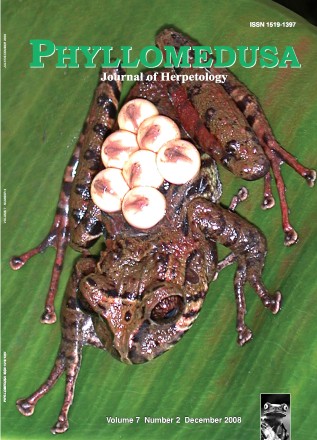Diet, microhabitat and time of activity in a Pristimantis (Anura, Strabomantidae) assemblage
DOI:
https://doi.org/10.11606/issn.2316-9079.v7i2p109-119Keywords:
Anura, Strabomantidae, Andean anurans, cloud forest, resource segregationAbstract
We tested if the richness and abundance of six closely related species of Pristimantis significantly varied among three transects located at different distances from a creek in an Andean cloud forest. We found that richness and abundance of frogs varied significantly among transects, being the transect located at the forest interior the richest in frog species and number of individuals. We chose these more crowded sites to evaluate resource use differences among the species. We evaluated ecological variables such as microhabitat, diet, and time of activity in these species that are similar in morphology and body size, to determine whether they have differences in the use of these resources. Most specimens perch on leaves at heights within 1.5 and 2.0 m of the ground and are nocturnal; only P. douglasi was found with diurnal and nocturnal activity. The species had similar diets, they ingested a wide spectrum of prey sizes that are similar among species, months, and between transects. Almost all collected frogs were juveniles and were found during every single month of sampling suggesting continuous reproduction; however, adults and juveniles of P. douglasi were absent during some of the drier months, indicating seasonality. Thus, we found that most of these Pristimantis species occupy the forest interior and that there is no a strong segregation in the use of the evaluated resources, only one species had a slight difference in activity and reproductive time.Downloads
Download data is not yet available.
Downloads
Published
2008-12-01
Issue
Section
Articles
License
All material originally published in Phyllomedusa belongs to Escola Superior de Agricultura Luiz de Queiroz - Universidade de São Paulo. All contents are under a license of Creative Commons BY-NC-ND.How to Cite
Arroyo, S. B., Serrano-Cardozo, V. H., & Ramírez-Pinilla, M. P. (2008). Diet, microhabitat and time of activity in a Pristimantis (Anura, Strabomantidae) assemblage. Phyllomedusa: Journal of Herpetology, 7(2), 109-119. https://doi.org/10.11606/issn.2316-9079.v7i2p109-119



 Impact Factor (JCR): 0.600
Impact Factor (JCR): 0.600 CiteScore: 1.0
CiteScore: 1.0